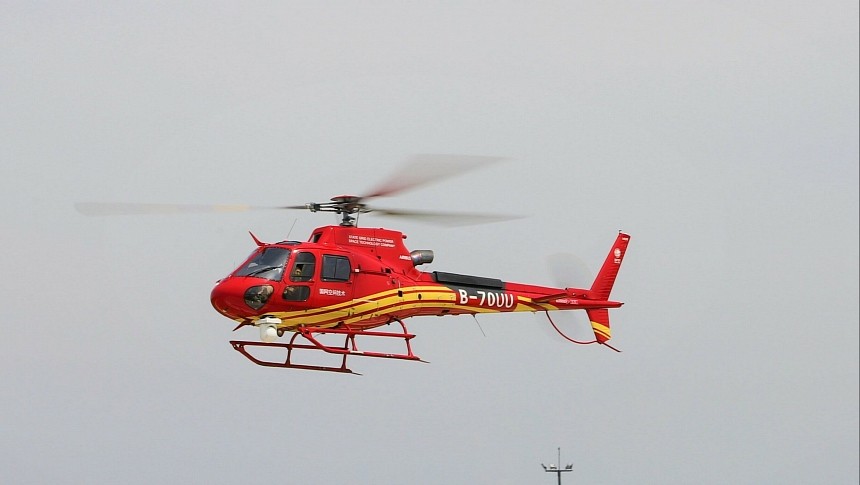SAF (Sustainable Aviation Fuel) is often mentioned in connection to airplanes, but helicopters like it just as much. Until the day when eVTOLs (electric vertical take-off and landing) can replace conventional rotorcraft entirely, existing choppers can cut their environmental footprint by using sustainably-sourced alternative fuel. It's starting to happen all over the world.
The Airbus H125 is writing aviation history by pioneering the use of SAF for rotorcraft. Last summer, an H125 completed a trailblazing flight in Japan. It flew for half an hour with 600 liters (158 gallons) of "Susteo 1" onboard. Susteo 1 is a type of alternative fuel comprised of 10% SAF, mixed conventional aviation fuel (known as Jet A-1 fuel). Euglena, the company that produces Susteo 1, is a biotechnology company also based in Japan. It was a double whammy – Japan's first SAF-powered helicopter flight used domestically-produced alternative fuel.
Prior to that, a different Airbus chopper, the H225, had completed the brand's first flight using SAF. In November 2021, the H225 used unblended SAF for a short flight demonstration at the Airbus headquarters in Marignane, France. That was one of the earliest tests for confirming SAF's compatibility with helicopter engines. In addition to dramatically lowering emission levels, this green jet fuel has two essential benefits – it doesn't require engine modifications or affect aircraft performance.
A year after that trailblazing flight in Japan, a different H125 writes SAF history in China. This particular chopper is operated by SGST (State Grid Space Technology) and recently completed a demonstration at Hefei Shiwan Airport in China.
The H125 used a mix of 40% SAF and kerosene for this flight demonstration. Just like in Japan's case, a domestic supplier provided the fuel. The cooperation between Airbus and CNAF (China National Aviation Fuel) goes even beyond this flight demonstration. The two companies recently signed an MoU (Memorandum of Understanding) to increase SAF production and supply in both countries.
The Chinese-operated H125 was equipped with a Safran ARRIEL 2D engine. Safran has worked with Airbus on SAF-related projects for a long time and boasts a complete engine portfolio that's certified to run efficiently on 50% SAF.
The industry has two main goals related to SAF, with the end of this decade as the deadline. First, it wants to increase the use of SAF to 10% across the industry. Second, it hopes to use 100% unblended SAF by 2030. Current regulations limit the amount of SAF in conventional fuel blends to a maximum of 50%.
Airbus is undisputedly one of the most avid SAF supporters worldwide. In addition to these pioneering demonstrations in Japan and China, it hit another milestone with the first helicopter to carry SAF in both engines. Plus, it's working with multiple industry partners through the SAF User Group, founded in 2021.
Prior to that, a different Airbus chopper, the H225, had completed the brand's first flight using SAF. In November 2021, the H225 used unblended SAF for a short flight demonstration at the Airbus headquarters in Marignane, France. That was one of the earliest tests for confirming SAF's compatibility with helicopter engines. In addition to dramatically lowering emission levels, this green jet fuel has two essential benefits – it doesn't require engine modifications or affect aircraft performance.
A year after that trailblazing flight in Japan, a different H125 writes SAF history in China. This particular chopper is operated by SGST (State Grid Space Technology) and recently completed a demonstration at Hefei Shiwan Airport in China.
The H125 used a mix of 40% SAF and kerosene for this flight demonstration. Just like in Japan's case, a domestic supplier provided the fuel. The cooperation between Airbus and CNAF (China National Aviation Fuel) goes even beyond this flight demonstration. The two companies recently signed an MoU (Memorandum of Understanding) to increase SAF production and supply in both countries.
The Chinese-operated H125 was equipped with a Safran ARRIEL 2D engine. Safran has worked with Airbus on SAF-related projects for a long time and boasts a complete engine portfolio that's certified to run efficiently on 50% SAF.
The industry has two main goals related to SAF, with the end of this decade as the deadline. First, it wants to increase the use of SAF to 10% across the industry. Second, it hopes to use 100% unblended SAF by 2030. Current regulations limit the amount of SAF in conventional fuel blends to a maximum of 50%.
Airbus is undisputedly one of the most avid SAF supporters worldwide. In addition to these pioneering demonstrations in Japan and China, it hit another milestone with the first helicopter to carry SAF in both engines. Plus, it's working with multiple industry partners through the SAF User Group, founded in 2021.







